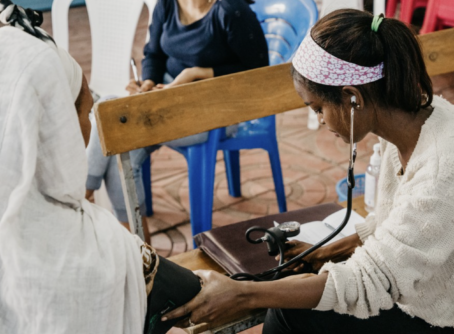
Madi Allen’s article on fast fashion and the image of God continues our series on ending human trafficking. When many people think about human trafficking, they may think primarily about sex trafficking since that gets the most attention in the headlines. However, a large portion of the international human trafficking industry actually refers to forced labor. Individuals are tricked or forced to make a difficult decision to work for little to no pay for abusive and demanding companies that keep them trapped as a worker and unable to choose their own employment. They work long hours in often dangerous working conditions and enable these companies to turn a large profit on cheap clothing. Keep reading to learn more.
If you are a fashion fanatic or avid social media consumer you are probably familiar with the term fast fashion. Fast fashion refers to the extremely low-priced clothing production that moves fashion from the runway to market by mass production and quick inventory turnarounds. This term began to circulate among the general population in 2013, when the Rana Plaza clothing manufacturing complex in Bangladesh collapsed, killing over 1,100 garment workers who were forced to work in dangerous conditions. It was in this manufacturing plant that clothes for brands such as Zara, The Children’s Place and Walmart were produced by workers being paid as little as $35 a month. Fast fashion continues to make an infamous name for itself in headlines as the negative environmental impact of the fashion industry has come to light. Currently, clothing production is responsible for more annual emissions than all international flights and shipping combined. According to CBC News, in 2021 a Canadian investigation found high levels of lead and cancer causing chemicals in the clothing produced by Shein, one of the most popular and current fast fashion brands. The company assured consumers that limited exposure to these chemicals would not cause any harmful health impacts but they could not make these same promises to the garment workers who inhale those chemicals regularly. These abhorrent working conditions are deadly but many garment workers have no other choice than to stay. Internationally women and children are often excluded from well paying, safer jobs which forces them to take positions in fast fashion factories. In much of the world, the responsibilities of caring for children and a home fall on the woman, making them much less likely to form unions and protest poor working conditions. These vulnerabilities are exploited by fast fashion companies as they prey on the precarious position of women and children in society. Even as the evidence of forced labor, unlivable working conditions and environmental damage increase, the fast fashion industry continues to grow.
Fast fashion has taken over the fashion industry. Some of the most popular brands like H&M, Zara, Gap, and Urban outfitters are the biggest fast fashion offenders, churning out new trends almost daily. This was not always the case in the industry. There was a time when there were only three or four major fashion seasons a year and people invested in clothing items that were made to last for years. By the early 2000’s cheap trendy clothing that could be purchased quickly and discarded even quicker became the new normal. The rise of social media has only exacerbated this problem. Now, instead of four seasons there are hundreds of microtrends a year. Brands are able to identify the trends of the week and quickly churn out a cheap polyester version. Fast fashion websites update thousands of new styles daily to keep up with these trends. Influencers post videos on TikTok, Instagram and Facebook to teach their followers how to use fast fashion to find the ‘dupe’ of the most popular trending clothing item of the moment. Microtrends go out of style so quickly that many people buy clothing only intending to wear it once or twice. With items sold at prices as low as $3, consumers have no problem buying and discarding these items haphazardly. Young people especially are conditioned to buy fast fashion. Generation Z and the majority of millennials have only known a world in which they had access to fast fashion. From 2000 to 2014 the cost of clothing actually declined in spite of increasing rates of inflation. Why should consumers spend more money when they could buy a t-shirt for $5 or a pair of jeans for $30? Younger generations have been some of the loudest voices when it comes to environmental justice, the exploitation of workers, and the dangers of unsustainable production, so why, when it comes to fast fashion, have their actions not matched their voices?
There are many reasons that fast fashion has continued to grow but one factor has been the lack of value for the people who are producing the clothing we wear. If as Christians we believe that garment workers are made in the image of God, then we can not be blasé about their suffering. The fast fashion industry profits off the forced labor of the most vulnerable people internationally, financially insecure women and children. An estimated 170 million children are engaged in child labor — work for which they are too young or for which is not suitable for children, according to the Guardian. Garment workers around the world are severely underpaid for backbreaking work and some are not paid at all. Some workers put up with impossible quotas, tiresome hours, and dangerous conditions just to be able to afford to feed their families that night. These conditions do not support the flourishing of individuals, families or their communities. Fast fashion companies are responsible for these human rights abuses and need to be held accountable for tracking the supply chain of the resources that go into creating their products. People who create the demand for cheap fashion products and consume the items that fast fashion companies produce need to own up to their responsibility and actively fight for the justice deserved by these men, women and children, created in the image of God. However, if consumers demand cheap clothing and do not care about who is creating their clothes, what incentives do large corporations have to maintain ethical practices?
The question is not if Christians should be consumers but how can Christians consume in a way that proclaims the glory of God and God’s beautiful design for creation.
The problem of fast fashion is not just about how consumption affects others and the environment, but also how it impacts the consumer’s flourishing as well. Forced labor, sweatshops and inhumane working conditions have not been kept secret in our world of constant information. Data has shown that people’s knowledge about fast fashion’s ethical practices does not change the amount that people buy from fast fashion realtors. Is it possible that convenience has become a bigger priority than honoring the imago dei of our brothers and sisters hurt by the fast fashion industry? The distance between consumer and maker has made it too easy to harden our hearts to the serious impacts of consumerism. James K.A. Smith explores this idea in his book Desiring the Kingdom. He says,
“Because our hearts are oriented primarily by desire, by what we love, and because those desires are shaped and molded by the habit-forming practices in which we participate, it is the rituals and practices of the mall — the liturgies of mall and market — that shape our imaginations and how we orient ourselves to the world. Embedded in them is a common set of assumptions about the shape of human flourishing, which becomes an implicit telos, or goal, of our own desires and actions. That is, the visions of the good life embedded in these practices become surreptitiously embedded in us through our participation in the rituals and rhythms of these institutions.”
The question is not if Christians should be consumers but how can Christians consume in a way that proclaims the glory of God and God’s beautiful design for creation.
The fast fashion industry is intertwined within the global economy and consumers’ regular shopping habits. Even if it was possible to eliminate the demand for fast fashion overnight, it would leave millions of garment workers without jobs. Fast fashion companies are currently filling an employment gap for women and children globally. These workers do not have another opportunity to earn a wage for their families outside of the industry, and that is why they stay in deplorable working conditions at the factories. Sustainable fashion advocate Nada Elbrarshoumi explains it this way: “For many women living in poverty-stricken countries, a job in the textile industry is the best of a bad situation.” A complete boycott of consuming clothing is not the answer but accepting “the best of a bad situation” is not helpful either. On an individual level it is important to increase the demand for ethically produced fashion. Support fair trade goods, and clothing made by smaller international businesses that pay their workers a living wage, or bigger brands that have transparency around their manufacturing practices like Reformation, Able, Everlane, Patagonia and Levi’s. It is important to mention that accessibility and affordability do play an important role in this conversation. The high cost and lack of accessibility make it more challenging for people from all economic backgrounds to afford ethically sourced goods. This can especially be a burden on larger families with children who are constantly growing and needing new clothes. This is why it is important that people who can afford to buy the more expensive items use their purchasing power well.
It is impossible to love our neighbors well while ignoring their suffering in forced labor and deadly conditions.
There is a limit to how much impact simply changing one consumer’s habits can make. The most important players in this industry are the billion dollar companies that profit off of forced labor. These businesses must be held accountable and encouraged to treat their employees with the dignity and respect they deserve. Several pieces of legislation have been introduced to both state governments and the federal government to demand more transparency around labor practices from corporations and set stricter regulations on emissions from the fashion industry. The United States regulates many industries that import goods into the United States, but there has been a lack of regulations on the fashion industry. Individuals and churches have the opportunity to be advocates for garment workers and demand more from our government to protect these image bearers. Call your senators, representatives and local legislators to advocate for the women who can not escape the poverty traps built by these companies. Elevate the voices of the vulnerable when fast fashion brands try to silence their workers with intimidation and fear tactics. Use your purchasing power to support brands that pay their garment workers a living wage and have a transparent supply chain. It is impossible to love our neighbors well while ignoring their suffering in forced labor and deadly conditions.
Madi Allen is the Advocacy Manager at the Center for Public Justice. She is a graduate of Covenant College with a B.A. in Community Development. She is also a current candidate for her Masters in Public Health at the University of Virginia School of Medicine. Before Madi joined the CPJ team she worked at the Maternal Mental Health Leadership Alliance as a passionate advocate for women, and children. Her conviction to love her neighbor well is what led her into a career in advocacy.





